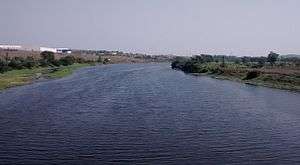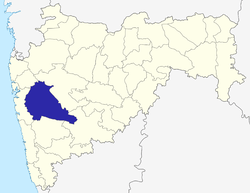Indrayani River
The Indrayani river originates in Kurvande village near Lonavla, a hill station in the Sahyadri mountains of Maharashtra.[1] Fed by rain, it flows east from there to meet the Bhima river, through the Hindu pilgrimage centers of Dehu and Alandi. It follows a course mostly north of the city of Pune[2] It is revered as a holy river and is associated with such great religious figures such as Sant Tukaram and Dnyaneshwar.
| Indrayani River | |
|---|---|
 Indrayani River at Moshi | |
| Location | |
| Country | India |
| State | Maharashtra |
| Physical characteristics | |
| Source | |
| • location | Lonavla, Pune, Maharashtra, India |
| Mouth | Bhima River |
• location | Tulapur, Pune, Maharashtra, India |
There is a hydroelectric dam called Valvan Dam on the Indrayani at Kamshet.[3]
Save Indrayani Action Committee
The Save Indrayani Action Committee (SAC), comprising environment groups and Varkaris, has decided to conduct a detailed study on the causes of pollution of the Indrayani river and support the local civic bodies take preventive measures with the help of the state government. They have a blog at ibks.blogspot and also formed groups on various community sites.
The action committee formed groups to study the river from its origin near Lonavla, to right up to where it joins the Bhima river.
The study groups of the action committee consist of experts who will document the reasons of pollution by clicking pictures, preparing short films and by collecting water samples. The study is expected to be completed by March next year. The report and the demands would then be submitted to the state government as also to government bodies, like the Maharashtra Pollution Control Board and the Pimpri-Chinchwad Municipal Corporation.
Since local civic bodies such as the Lonavla Municipal Council, the Vadgaon Gram Panchayat, the Talegaon Dabhade Municipal Council and the Dehu Gram Panchayat do not have necessary facilities to treat domestic effluents which get released in the river directly., the action committee would assist the civic bodies in setting up these essential facilities with the help of the state government. Another study group would be examining geographical details of the river, its original width and the changes that have happened over time.
